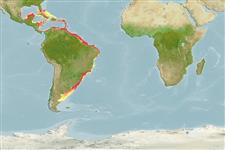Environment: milieu / climate zone / depth range / distribution range
Ecologia
marino; salmastro demersale; distribuzione batimetrica ? - 190 m (Ref. 47377), usually 18 - 70 m (Ref. 5217). Subtropical; 26°N - 53°S, 98°W - 34°W
Western Atlantic: Belize and Jamaica southward to Argentina Antilles, Central and South America (Ref. 26938).
Length at first maturity / Size / Peso / Age
Maturity: Lm 26.2 range ? - ? cm
Max length : 45.0 cm TL maschio/sesso non determinato; (Ref. 104706); 45.0 cm TL (female); common length : 30.0 cm TL maschio/sesso non determinato; (Ref. 3822); peso massimo pubblicato: 349.90 g (Ref. 131022)
Spine dorsali (totale) : 9 - 10; Raggi dorsali molli (totale) : 11 - 12; Spine anali: 1; Raggi anali molli: 10.
Found on sand or muddy bottoms of the continental and insular shelves. Occasionally occurs over reefs. Feeds on shrimps, crabs, other crustaceans and fishes. Traded as an aquarium fish at Ceará, Brazil (Ref. 49392).
Life cycle and mating behavior
Maturità | Riproduzione | Deposizione | Uova | Fecundity | Larve
Miller, G.C. and W.J. Richards, 1978. Triglidae. In W. Fischer (ed.) FAO species identification sheets for fishery purposes. West Atlantic (Fishing Area 31). FAO, Rome. Vol. 5. pag.var. (Ref. 3822)
IUCN Red List Status (Ref. 130435: Version 2024-2)
Threat to humans
Harmless
Human uses
Pesca: scarso interesse commerciale; Acquario: Commerciale
Strumenti
Special reports
Download XML
Fonti Internet
Estimates based on models
Preferred temperature (Ref.
123201): 15 - 27.9, mean 26.1 °C (based on 464 cells).
Phylogenetic diversity index (Ref.
82804): PD
50 = 0.5000 [Uniqueness, from 0.5 = low to 2.0 = high].
Bayesian length-weight: a=0.00933 (0.00762 - 0.01143), b=3.00 (2.95 - 3.05), in cm total length, based on LWR estimates for this species (Ref.
93245).
Trophic level (Ref.
69278): 3.8 ±0.63 se; based on food items.
Generation time: 8.5 ( na - na) years. Estimated as median ln(3)/K based on 1
growth studies.
Resilienza (Ref.
120179): Basso, tempo minimo di raddoppiamento della popolazione 4.5 - 14 anni (K=0.13).
Fishing Vulnerability (Ref.
59153): High vulnerability (57 of 100).
Nutrients (Ref.
124155): Calcium = 68.1 [36.1, 163.5] mg/100g; Iron = 0.978 [0.538, 1.847] mg/100g; Protein = 17.4 [15.1, 20.4] %; Omega3 = 0.584 [0.275, 1.520] g/100g; Selenium = 30 [14, 70] μg/100g; VitaminA = 15.6 [6.0, 39.3] μg/100g; Zinc = 0.885 [0.634, 1.252] mg/100g (wet weight);
